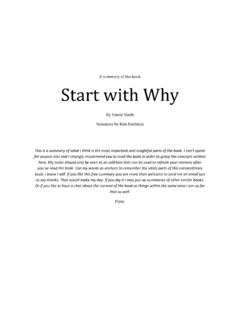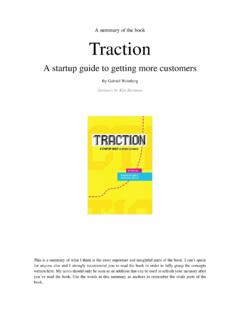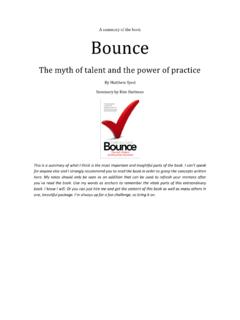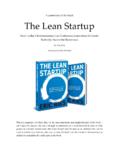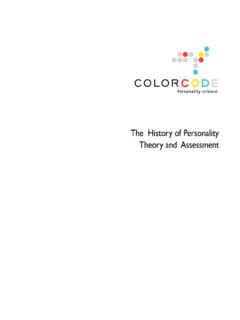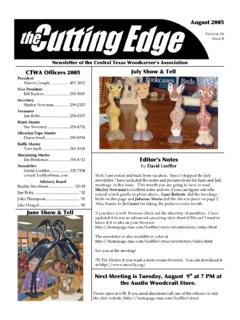Transcription of The Element - Kim Hartman
1 A summary of the book The Element How finding your passion changes everything By Sir Ken Robinson Summary by Kim Hartman This is a summary of what I think is the most important and insightful parts of the book. I can t speak for anyone else and I strongly recommend you to read the book in order to fully grasp the concepts written here. My notes should only be seen as an addition that can be used to refresh your memory after you ve read the book. Use the words in this summary as anchors to remember the vitals parts of the book. More book summaries at Contact me at 1 Contents Description from amazon .. 2 Chapter 1: The Element .. 3 Chapter 2: Think differently .. 4 Chapter 3: Beyond imagining .. 5 Chapter 4: In the Zone .. 6 Chapter 5: Finding your tribe .. 7 Chapter 6: What will they think?
2 8 Chapter 7: Do you feel lucky?.. 9 Chapter 8: Somebody help me .. 10 Chapter 9: Is it too late? .. 11 Chapter 10: For love or money .. 12 Chapter 11: Making the 13 More book summaries at Contact me at 2 Description from amazon The Element is the point at which natural talent meets personal passion . When people arrive at the Element , they feel most themselves and most inspired and achieve at their highest levels. With a wry sense of humor, Ken Robinson looks at the conditions that enable us to find ourselves in the Element and those that stifle that possibility. Drawing on the stories of a wide range of people, including Paul McCartney, Matt Groening, Richard Branson, Arianna Huffington, and Bart Conner, he shows that age and occupation are no barrier and that this is the essential strategy for transforming education, business, and communities in the twenty-first century.
3 A breakthrough book about talent, passion , and achievement from one of the world's leading thinkers on creativity and self-fulfillment. More book summaries at Contact me at 3 Chapter 1: The Element Never underestimate the vital importance of finding early in life the work that for you is play. This turns possible underachievers into happy warriors. The Element : The place where the things you love to do and the things that you love to do come together. The Element is the meeting point between natural aptitude and personal passion . For the most part, people seem to think that life is linear, that our capacities decline as we grow older, and that opportunities we have missed are gone forever. Many people have not found their Element because they don t understand their constant potential for renewal.
4 When people are in their Element , they connect with something fundamental to their sense of identity, purpose and well-being. Being there provides a sense of self-revelation, of defining who they really are and what they re meant to be doing with their lives. High-achievers often share similar attitudes, such as self-belief, optimism, ambition and frustration. More book summaries at Contact me at 4 Chapter 2: Think differently Common sense is the enemy of creativity and innovation. As soon as something seems the most obvious thing in the world, it means that we have abandoned all attempts at understanding it. Human intelligence seems to have three main features: It is extraordinary diverse: you use multiple parts of the brain in every task you perform and it is the dynamic use of the brain finding new connections between things that true breakthrough occurs.
5 It is tremendously dynamic: It is entirely distinctive: every person s intelligence is unique as a fingerprint Intellectual growth and creativity come through embracing the dynamic nature of intelligence. Growth comes through analogy, through seeing things connect rather than only seeing how they might be different. More book summaries at Contact me at 5 Chapter 3: Beyond imagining Children do not see anything so strange and different about art. They accept it; they understand it; they love it. But the world is going to pick them apart; this does not look like a tree, this does not look like a man. Imagination is what sets human beings apart from very other species on earth. Imagination underpins every uniquely human achievement. It lets us visit the past, contemplate the present, and anticipate the future.
6 Through imagination we can not only bring to mind things that we have experienced but things that we have never experienced. To be creative you actually have to do something. It involves putting imagination to work to makes something new, to come up with new solutions to problems, even to think of new problems and questions. Creativity is applied imagination. Usually the creative process begins with an inkling which requires further development. Creativity involves several different processes that wind through each other. 1. The first is generating new ideas. Imagining different possibilities, considering alternative options. 2. The creative process also involves developing these ideas by judging which work best or feel right. These processes don t come in a predictable sequence they interact with each other.
7 Creativity always involves using media of some sort to develop ideas. The medium can be anything at all. The reason that so many people think they re not creative is that they haven t found their medium. To develop our creative abilities, we also need to develop our practical skills in the media we want to use. Sometimes when we are playing around with ideas and laughing, were most open to new thoughts. Creative thinking depends greatly on what s sometimes called divergent or lateral thinking, and especially on thinking in metaphors or seeing analogies. Being creative is about making fresh connections so that we see things in new ways and from different perspectives. Lateral thinking: using reasoning that is not immediately obvious. We don t just see the world as it is; we interpret it through the particular ideas and beliefs that have shaped our own cultures and our persona outlook.
8 All of these stand between us and our raw experiences in the world, acting as a filter on what we perceive and how we think. More book summaries at Contact me at 6 Chapter 4: In the Zone One of the strongest signs of being in the zone is a sense of freedom and authenticity. When we are doing something that we love and are naturally good at, we are much more likely to feel entered in our true sense of self to be who we truly are. When you are connecting this way with your deep interests and natural energy, time tends to move more quickly, more fluidly. Meta-state: where ideas comes more quickly, as if you are tapping a source that makes it significantly easier to achieve your task. You develop a facility for the thing you are doing because you ve unified your energy with the process and the efforts you are making.
9 Once you think about being in the zone, you are immediately out of it. Flow: happens when psychic energy or attention is invested in realistic goals, and when skills match the opportunities for action. The optimal experience: is comprised by the elements of enjoyment. These include facing a challenge that requires a skill one possesses, concentration on the task at hand that allows one to forget everything else, the loss of self-consciousness, and the sense that time transforms during the experience. The activity that consumes us becomes intrinsically rewarding. Being in the zone doesn t take energy away it gives it to you. Activities we love fill us with energy even when we are physically exhausted. When people place themselves in situations that lead to their being in the zone, they tap into a primal source of energy.
10 Mental energy isn t a fixed substance. It rises and falls with our passion and commitment to what we are doing at the time. The key difference is in our attitude, and our sense of resonance with an activity. These peak experiences are associated with physiological changes in the body there may be a release of endorphins in the brain and of adrenaline through the body. There may be an increase in alpha wave activity and changes in our metabolic rates and in the patterns of our breathing and heartbeats. When we connect with our own energy we are more open to the energy of other people. The more alive we feel, the more we can contribute to the lives of others. When people are in the zone, they align naturally with a way of thinking that works best for them. And when people use a thinking style completely natural to them, everything comes more easily.
